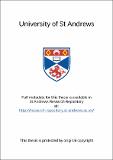Files in this item
Mechanisms in an argon ion pulsed laser
Item metadata
| dc.contributor.advisor | Maitland, Arthur | en |
| dc.contributor.author | Taylor, Andrew Ramage | en |
| dc.coverage.spatial | 114 p | en |
| dc.date.accessioned | 2021-04-08T08:57:21Z | |
| dc.date.available | 2021-04-08T08:57:21Z | |
| dc.date.issued | 1968 | |
| dc.identifier.uri | https://hdl.handle.net/10023/21874 | |
| dc.description.abstract | Although many argon ion lasers, both pulsed and D.C., have been built and used, the mechanisms which cause the required population inversion in the gas are still doubtful, and different views are held by different workers in the field. Many possible mechanisms have been proposed, and the problem of deciding which mechanisms are dominant under given operating conditions, still remains. The first oscillation In an ion laser was observed by Bell (1) o in a pulsed mercury-helium discharge at wavelengths of 6150Å and 5678 Å, which corresponded to two lines of the Hg II spectrum. There followed observations of laser action in ionised krypton (2), xenon (2) and chlorine (3), as well as many other ions, giving a range of wavelengths extending from the near infrared into the ultraviolet regions of the spectrum. The first observation of oscillation in the ionised argon system was made by Bridges (4) using a pulsed discharge when he observed oscillation on 10 wave-lengths in the A II spectrum. The strongest of these were the wavelengths 4880 Å and 5145 Å. Very soon after Gordon et al (5) observed continuous oscillation on 10 wavelengths of the A II spectrum as well as several wavelengths of the Kr II and Xe II spectra. There followed reports on the behaviour of the oscillation in A II under a wide variety of conditions and measurements of the relative gain of the various wavelengths. Many workers in the argon ion laser field have proposed excitation mechanisms, but the lack of measurements of the fundamental parameters of the system (e.g. electron density, electron temperature etc) have made it difficult to decide which mechanisms are feasible. The problem is that electron densities of the order of 10^-15 cm^-3 are common with electron temperatures in the region of 10^4 to 10^5°K. Probe measurements in this region are notoriously unreliable, while microwave measurements fail completely. An extension of the microwave technique using optical frequencies, to permit penetration of the plasma at high electron densities, provides an estimate of the parameters involved, and line broadening due to the Stark effect can also be used to determine the charged particle density. Using spectroscopic techniques Kitaeva, Osipov and Sobolev (6) have measured electron densities and electron temperatures in an argon ion laser at a current density of about 400 Acm^-2 Measurements from the Doppler broadening of the argon ion spectrum enabled estimates of the ion temperature to be made. There is noinformation available for current densities of about 5000 Acm^-2 and pressures of 30 m torr, so extrapolations must be made from the Russian data to give estimates of the parameters to deduce which mechanisms are important. The behaviour of the system can then be predicted and the predictions compared with observation to deduce which mechanism is dominant. | en |
| dc.language.iso | en | en |
| dc.publisher | University of St Andrews | en |
| dc.subject.lcc | TK7882.T2 | |
| dc.subject.lcsh | Argon lasers | en |
| dc.title | Mechanisms in an argon ion pulsed laser | en |
| dc.type | Thesis | en |
| dc.type.qualificationlevel | Doctoral | en |
| dc.type.qualificationname | MSc Master of Science | en |
| dc.publisher.institution | The University of St Andrews | en |
This item appears in the following Collection(s)
Items in the St Andrews Research Repository are protected by copyright, with all rights reserved, unless otherwise indicated.

